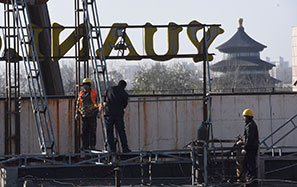Revisiting Deng and the socialist market economy
China has come a very long way since Deng Xiaoping articulated his vision of a reformed and modern China in December 1978. More than 35 years after the historical Third Plenum of the 11th Central Committee of the Communist Party of China in December 1978, "socialist market economy" has become a frequently used phrase in modern economic and development literature.
Introduced by Deng in reforming modes of production and organization of economic institutions in China, the concept has survived the test of time. China is well on its way to catching up with the world's largest economy, the United States. It is also the world's leading economy in terms of several international economic and business indicators.
The remarkable aspect of the "socialist market economy" is in its effort to reconcile what used to seem irreconcilable. For some people, socialism and markets are still mutually antithetical. It was more so at the time when Deng introduced it to the world, sharply divided as it was between the ideological poles of state-driven socialist planning systems and market-driven economic frameworks.
Deng understood the importance of economic gains in incentivizing output, and was decisive in urging farmers to respond to such incentives. The boldness of the decision could hardly be overstated in a country where agricultural crises and food shortages were not distant memories, and whose large population was vulnerable to supply shocks. Along with the boldness, Deng's economic vision was characterized by surprising clarity in the sequencing of reforms.
Agriculture came first, followed by loosening of controls on foreign investment and creation of gigantic-scale manufacturing units. Indeed, there was no holding back of China once the first phase of economic reforms was over. Deng's successors took forward his legacy by allowing the market to respond to pricing signals and never letting go of opportunities to encourage investment.
The socialist character of the Chinese economy is evident in the limitations it imposes on unchecked functioning of the market in several spheres. Typical neo-classically managed economies would minimize possibilities of market failures by institutionalizing regulators. Autonomous regulators, arguably independent in their functioning from state influence, would attempt to coordinate market movements in various sectors of the economy. China is no stranger to regulators and regulations, except that unlike the more prevalent Anglo-Saxon regulation models, it has unshakable faith in the ability of the State to regulate. State regulation has resulted in calibrated fashioning of the market in China.
"Opening-up" has been gradual with the authorities carefully taking note of policy repercussions, if any, before enlarging their scope. The calibrated preference is visible even today as China experiments with new generation reforms in latest laboratories like the Shanghai Free Trade Zone.
China's has not been an entirely unblemished story. High economic growth has had its side effects. These include widening of economic and regional disparities and a heavy toll on sustainable indicators through depletion of water resources, and massive carbon emission and pollution.
China's success and the more undesirable consequences of that success have influenced modern development discourse. While China's success in building infrastructure, reducing poverty and upgrading slums have become almost mythical, the income inequality and pollution indices have also become yardsticks in different contexts.
How to explain the social and economic costs of China's growth on the way to building up of socialist market economy?
It is important to remember that the experiment of guiding the market with socialist oversight and outreach is an unprecedented project. Being top-down in order, it is also vulnerable to setbacks dealt by local characteristics. This probably explains why Guangdong province succeeded in creating exemplary special economic zones while Hainan province didn't.
Market forces are genies that once uncorked can produce spectacular results. The qualitative aspects of these results become known much later.
Almost two decades after the launch of reform and opening-up, Chinese authorities responded to widening regional disparities by proposing specific development plans for its relatively underdeveloped western region. But the western region will still take a lot of time and efforts to catch up with the eastern and southern parts of the country. Businesses and markets do not always respond to even the most favorable of incentives, unless they can see enabling conditions, which are far more in China's coastal provinces than its hinterland.
The socialist aspect of the economic policy has helped China take quick action wherever gaps have emerged. On many occasions, the socialist State and its organs have encouraged and helped businesses. But a pro-business outlook is not necessarily pro-market. There are probably sectors and areas where several businesses have prospered because of their ability to use State organs to their advantage.
Nonetheless, these are areas where markets have not matured because of lack of competition. China's socialist market economy continues to experience the tension, but it needs to encourage more competition.
The author is a senior research fellow and head of Partnerships & Programmes at the Institute of South Asian Studies, National University of Singapore.


















